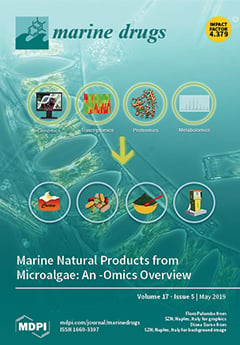Hizikia fusiformis (Harvey) Okamura is an edible marine alga that has been widely used in Korea, China, and Japan as a rich source of dietary fiber and essential minerals. In our previous study, we observed that the methanol extract of
H. fusiformis and its non-polar fractions showed potent protein tyrosine phosphatase 1B (PTP1B) and α-glucosidase inhibition. Therefore, the aim of the present study was to identify the active ingredient in the methanol extract of
H. fusiformis. We isolated a new glycerol fatty acid (
13) and 20 known compounds including 9 fatty acids (
1–
3,
7–
12), mixture of 24
R and 24
S-saringosterol (
4), fucosterol (
5), mixture of 24
R,28
R and 24
S,28
R-epoxy-24-ethylcholesterol (
6), cedrusin (
14), 1-(4-hydroxy-3-methoxyphenyl)-2-[2-hydroxy -4-(3-hydroxypropyl)phenoxy]-1,3-propanediol (
15), benzyl alcohol alloside (
16), madhusic acid A (
17), glycyrrhizin (
18), glycyrrhizin-6’-methyl ester (
19), apo-9′-fucoxanthinone (
20) and tyramine (
21) from the non-polar fraction of
H. fusiformis. New glycerol fatty acid
13 was identified as 2-(7′- (2″-hydroxy-3″-((5
Z,8
Z,11
Z)-icosatrienoyloxy)propoxy)-7′-oxoheptanoyl)oxymethylpropenoic acid by spectroscopic analysis using NMR, IR, and HR-ESI-MS. We investigated the effect of the 21 isolated compounds and metabolites (
22 and
23) of
18 against the inhibition of PTP1B and α-glucosidase enzymes. All fatty acids showed potent PTP1B inhibition at low concentrations. In particular, new compound
13 and fucosterol epoxide (
6) showed noncompetitive inhibitory activity against PTP1B. Metabolites of glycyrrhizin,
22 and
23, exhibited competitive inhibition against PTP1B. These findings suggest that
H. fusiformis, a widely consumed seafood, may be effective as a dietary supplement for the management of diabetes through the inhibition of PTP1B.
Full article






